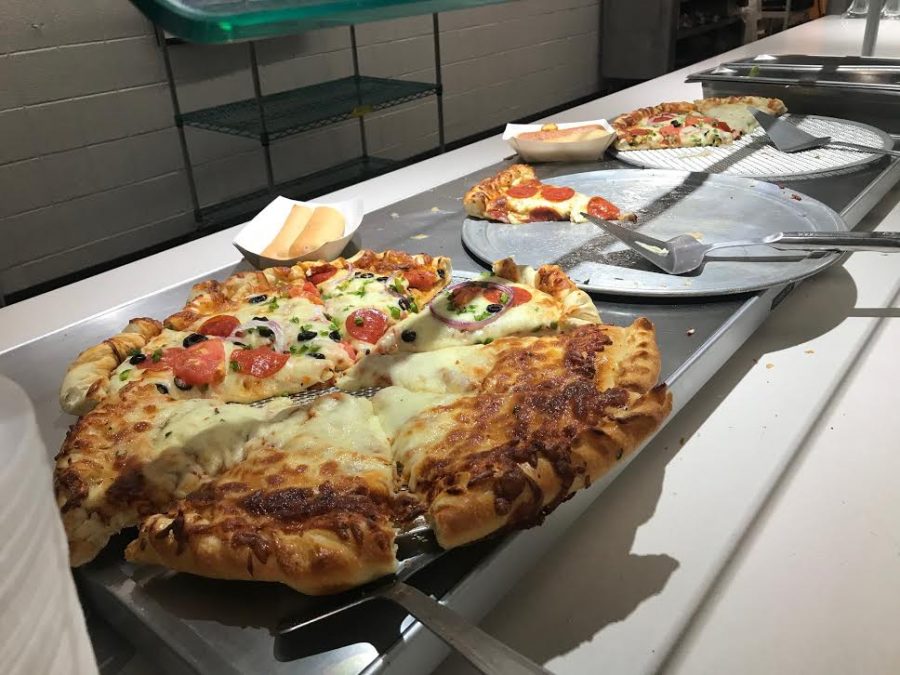Pioneer lunches: Serving up concerns about quality and choice
Pioneer students make their way into the crowded cafeteria, shouting and shoving to reach their friends. Many assemble in long lines in the hallway outside, waiting for their chance to purchase lunch, but when they finally reach the front disappointment comes: The options they were hoping for have run out.
This year, the barriers designating different lines have been removed, making it harder to control the flow of students, so many just jump on line wherever they’re standing, while others patiently wait for a turn that never comes. Pioneer Junior Emma Pedroni-Meyer says this organization system is less than ideal. “They’ve changed it a bit since last year and so when I went in for the first time this year, I had no idea where anything was. It’d be good if they had big signs over where each of the [food options] are because when there are so many people in there waiting for lunch, it’s hard to tell,” she said.
Pedroni-Meyer also said that sometimes when they are running out of a certain option, the lines get hectic, frantic even. One Friday she tried to get the Domino’s Friday special. “When the pizza started running out people started scrambling and cutting in line to get pizza before other people. People were trying to cut me and shove me out of the way,” Pedroni-Meyer said. “I’m sure there was other stuff still left that they could have gotten but if people want pizza, maybe there should be a little more pizza.”
All the other food sold at lunch is provided by Chartwells Food Service. The head of the Department of Food Services, Tiffany Houston, said an average of 300-350 students, out of a total of about 2,000, buy lunch daily at Pioneer. To accommodate this, they prepare between 350 and 400 meals to be ready for both lunches. Food that is served by workers gets stored for the next day. All premade meals that are not purchased within the lunch periods are thrown away to avoid germs and bacteria.
“We do replenish the meals until we have placed all items out for service,” Houston said. “We make food fresh for each lunch period, to ensure that all meals are hot. We will never be exact with counts as we continue to increase the meal selections.”
It is also difficult for servers to predict how many of each option to make. Based on numbers from past days, the Food Service Department decides which meals to serve. “We never know what students will select from day to day,” Houston said. “We look at previous counts to determine how many of each menu item to make. We are always striving to offer a variety of fresh foods and without students placing orders before lunch, we are bound to miscalculate our numbers at times.”
Pioneer students also have complaints about the portion sizing of the hot lunches. “I am an athlete and they’re serving us little tiny sandwiches,” said junior Felicia Stewart. “It’s not enough; I’ll be hungry at practice.”
The money made by the food sales is an important source of revenue for the district. Each sale is reimbursed by the state to fund the schools. However, while students could always purchase more food, the question of what is a fair price for a full lunch is an issue to students. “Last week when I forgot my lunch, I went in for their special Domino’s Pizza for Fridays and I literally bought two slices of pizza and a bottle of water and it was about $8 and that’s pretty ridiculous,” said Pedroni-Meyer.
This is also a struggle for students who are part of the free and reduced lunch program. District-wide, 4,073 students qualify for these accommodations.
“People who qualify for free or reduced lunches have to eat that as their only option, and it often isn’t enough,” Pedroni-Meyer said. “I think it’s kind of the school’s responsibility to have good food for us, especially for that reason.”
The issue of the food’s quality is a major concern for many students who say it does not meet the standards of an acceptable meal.
“It’s not the best quality of food,” said Anna Kaganov, a sophomore. “Some days it’s better than others, though.”
While the students do not always find the lunch food satisfactory, the catering provided by Chartwells for school board meetings is known for its decadence, such as steak filets and shrimp. Chartwells is capable of producing good food, but has not demonstrated this at the schools, say some students.
Pedroni-Meyer has hopes for new innovations in the lunch system. “I know this isn’t very possible but it’d be nice if we had an actual chef come in and make food and be paid well instead of people heating up things that are shipped in,” she said.


